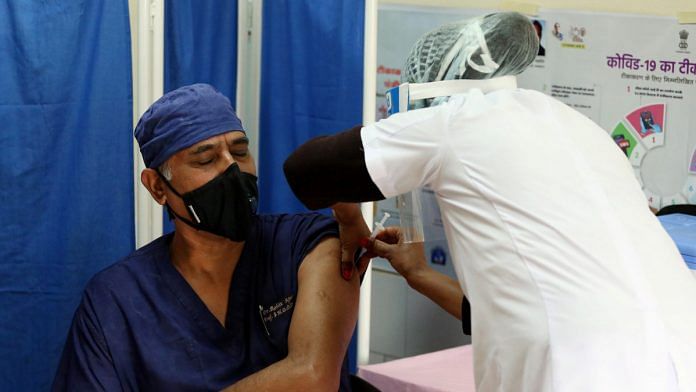New Delhi: Uttar Pradesh, Gujarat and Bihar contained the spread of Covid-19 the best. Kerala, Telangana and Andhra Pradesh have saved the most lives. Maharashtra has under-performed the most in restricting the spread of cases and in saving lives. These are the conclusions of the Economic Survey 2021 on the relative performance of Indian states during the pandemic.
Making a strong argument in favour of India’s early and stringent lockdown, the annual document on the economic health of the country, which was tabled in Parliament Friday, credited that decision both with India’s success in managing the pandemic and affecting a “V-shaped” economic recovery.
“India recognised that while GDP growth will recover from the temporary shock caused by the pandemic, human lives that are lost cannot be brought back. The response drew on epidemiological and economic research, especially those pertaining to the Spanish Flu, which highlighted that an early, intense lockdown provided a win-win strategy to save lives, and preserve livelihoods via economic recovery in the medium to long-term,” read the survey.
“The strategy was also motivated by the Nobel-Prize winning research in Hansen & Sargent (2001) that recommends a policy focused on minimising losses in a worst case scenario when uncertainty is very high. Faced with an unprecedented pandemic and the resultant uncertainty, loss of scores of human lives captured thus the worst-case scenario. This strategy was also tailored to India’s unique vulnerabilities to the pandemic,” it added.
Also read: Economic Survey expected to project 11% GDP growth, vaccinations to drive recovery
NCDs still the big killer
In an interesting take, the survey looked at the Covid numbers in advanced economies with better record of health spend to conclude that better health infrastructure is no guarantee that a country would be able to deal better with devastating pandemics like Covid.
The survey made the point that even though Covid is a communicable disease and has tested India’s health system preparedness, “71 per cent of global deaths and about 65 per cent of deaths in India are caused by non-communicable diseases”.
It also said: “As the next health crisis could possibly be drastically different from Covid-19, the focus must be on building the healthcare system generally rather than a specific focus on communicable diseases.”
It identified poor health outcomes, lack of access and high out-of-pocket expenditure as the persistent problems of India’s health system. It also pointed out that the richer states spend less of their GDP on healthcare but the limiting factor often is the lack of human resources.
“Although aggregate human resources for health density in India is close to the lower threshold of 23, the distribution of health workforce across states is lop-sided. Also, the skill mix (doctor/nurse-midwives ratio) is far from adequate,” the survey said.
“State-level variations in the density of health workers and the skill mix reflects that while Kerala and Jammu and Kashmir have a high density of doctors, states like Punjab, Himachal Pradesh and Chhattisgarh have a larger number of nurses and midwives but a very low density of doctors. Andhra Pradesh, Delhi and Tamil Nadu reflect a better balance of doctors and nurses and midwives,” it added.
The survey also said unregulated private enterprise can create significant negative effect.
Also read: Why Modi govt’s spending record in last 2 years dampens Budget 2021 hopes
PM-JAY increased insurance cover
Even though the Pradhan Mantri Jan Arogya Yojana (PMJAY) has managed just about 13.5 crore enrollments from among its 50 crore target beneficiaries, the Economic Survey said it has made a significant impact on the health insurance coverage in the country.
“Across all the states, the proportion of households with health insurance increased by 54 per cent for the states that implemented PM-JAY while falling by 10 per cent in states that did not. Similarly, the proportion of households that had health insurance increased in Bihar, Assam and Sikkim from 2015-16 to 2019-20 by 89 per cent while it decreased by 12 per cent over the same period in West Bengal,” it said.
“From 2015-16 to 2019-20, infant mortality rates declined by 12 per cent for states that did not adopt PM-JAY and by 20 per cent for the states that adopted it,” the survey said.
Bihar is among the states whose below par enrollments have now forced the National Health Authority to launch a special drive in the state to increase the beneficiary base.
Launched by Prime Minister Narendra Modi in 2018, PM-JAY aims to prevent impoverishment because of catastrophic health expenses by providing an annual health cover of Rs 5 lakh per family to all 10.74 families listed as per “deprivations” in the Socio-Economic Caste Census.
According to the data, the survey said dialysis accounts for a large chunk of the procedures under PM-JAY and its use did not diminish even during Covid. According to data from the National Health Ministry, every year about 2.2 lakh new patients with end stage renal disease get added in India, resulting in additional demand for 3.4 crore dialysis every year.
With inputs from Angana Chakrabarti.
Also read: Indian vaccine makers excellent example for lower income countries, Gavi deputy CEO says






